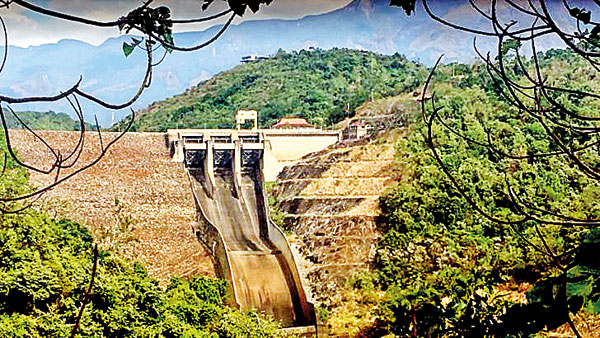News
To seal or not to seal Samanalaweva leak: CEB officials clash as experts say it is now or never
View(s):By Niranjala Ariyawansha
If the sealing of this huge water leak is not done now and immediately, grave devastation will take place on the right bank of the reservoir, causing harm to people downstream, the experts said in their warning to the CEB. The Sunday Times reliably learns that the sealing of this water leak is being delayed because of the proposed Upper Samanalawewa Mini Hydro Power Project, located close to the crevice.
The project is expected to generate 700kw of power, using water flowing out due to the leak.
Sri Lanka Energies, a CEB-controlled state-owned enterprise, has proposed that this mini hydropower plant be constructed in the Balangoda-Belihuloya-Pambahinna area.
Also, using water from the leak, detected 30 years ago, two mini-hydropower plants have been constructed in the past, close to the Samanalawewa Reservoir. One of them is owned by Sri Lanka Energies and the other belongs to a private company.
These two mini plants produce electricity at more than 85% of their capacities throughout the year, generating profits, according to a top CEB source.
However, the same source said that if the water leak was stopped, the CEB could earn 200 times more profit than what was generated by the two plants.
Under these circumstances, if the leak was sealed, permanently, these mini hydro plants would be able to generate power only when there was water in the Walawe River, he said.
An expert research team including, among others, Peradeniya University geologist Dr. Jagath Gunatilake, identified the place, from where the water leaked from the Samanalawewa Reservoir.
“The main leakage is positioned at elevation 450 masl (metres above the sea level). It is called ‘Adit G’ and is suspected to be a crucial location. There are several additional sinkholes. Adit G stretches for 215 metres and is positioned within a highly fractured rock zone, with its portal opening towards the reservoir,” Dr. Gunatilake told the Sunday Times.
On August 23, the CEB’s Additional General Manager (Generation) handed over to CEB General Manager Rohan Seneviratne a report titled ‘Urgent Attention on Attempts to Seal the Samanalawewa Leak.”
Due to the current drought, the reservoir has, for the first time, recorded the lowest level of water in its history, the report highlights, adding that the sealing of the leak has to begin immediately, considering it a national need.
At a recent meeting, Power and Energy Minister Kanchana Wijesekera informed top CEB officials that this water leak should be sealed immediately.
However, highly placed CEB source said that a group within the CEB was opposing the move.
He said that while officials spent time disputing about a serious matter of national importance, time was fast running out as inter-monsoon rains expected in October would fill the reservoir to levels above the crevice and make sealing work difficult, if not impossible.
The 120 MW Samanalawewa hydropower plant located at Belihuloya in the Walawe River basin was funded by Japan and the United Kingdom. It was commissioned in 1992 and its dam is the second largest dam in the country. The reservoir covers 897 hectares of land and is nourished by a 372 square kilometre catchment area. The estimated leakage from the crevice is 2 cubic metres per second.
The project cost was Rs 18 billion and the cost of leak repair was 2 billion rupees. The expected annual generation is 403 GWH.
From the initial stages, anomalous physical features that prevailed on the site were identified and as a result, the original plan was changed from time to time, said Dr. Gunatilake who participated in geological investigations during the construction.
This water leak was first detected in 1992, and during the past three decades, the CEB has committed substantial financial resources, countless hours of engineering effort, and diverse resources in pursuit of identifying the root cause of the leak along the right bank, CEB officials noted.
The Cabinet had decided in August 2021 that taking into consideration the massive financial loss due to this water leak, it should be sealed immediately.
However, prior to beginning this task, the System Control of the CEB submitted six conditions that should be addressed. However, all of these conditions have been successfully resolved, the CEB sources said: They are:
I. Reservoir storage has to be fully drawn to MOL (424 masl)
II. Both Broadlands and Uma Oya hydropower plants have to be commissioned.
III. The New Polpitiya-Hambantota 220 KV line with the Hambantota switching yard should to be completed.
IV. Sufficient generation capacity must be connected (Re-extension of ACE-Embilipitiya/ACE Matara).
V. Moussakele tunnel inspection and repair has to be completed.
VI. Consent from the Water Management Secretariat should be obtained.
“Now this is the golden opportunity to seal the leakages” Dr. Gunatilake asserted.
This will cost only about Rs. 100 million. Also, local expertise will suffice for this, and with the participation of all experts, the task can be completed in a month, the geologist said.
The AGM’s report submitted to the CEB GM has stated, “If this rare opportunity is not used to investigate the leak and take necessary actions to mitigate the leak, any failure of the right bank of the reservoir will result in questioning the CEB, inquiring the reasons of not using the today’s opportunity to mitigate the leak and diminishing the associated risk. Therefore, it is strongly recommended to lower the reservoir water level up to 414 (masl) and carry out the investigations and possible remedial actions through relevant branches immediately”.
When we inquired, Sri Lanka Energies General Manager Nandika Pathirage said that it was not possible to seal the water leak at the reservoir. He insisted that the two mini-hydropower plants should be maintained to generate power using water from the leakage.
He also said that this water leak provides relief to the people of Kalthota on the right bank of Samanalawewa.
“These experts mentioned many things during the past. Even though various things were done while wasting time and money, it was not possible to stop the leak. As of now, it is clean water that is flowing out and not muddy water. We can realise through this that there is no problem, internally. However, I would not say there is no risk here,” he stated.
The Samanalawewa Reservoir water is supplied for right bank downstream irrigation during four months of the year by the CEB although the reservoir was constructed for power generation only.
Our efforts to contact the CEB GM bore no results.
CEB Chairman Nalinda Illangakoon, when contacted on Friday afternoon by the Sunday Times to get his views on the delay in implementing the Cabinet decision, declined to comment over the phone saying he could provide information only if we visited him in his office.
| Energy and financial loss due to the water leakAnnual water loss – 71 MCM (Million Cubic Metres) Annual irrigation release – 30 MCM Annual irrigation demand – 65 MCM Annual actual loss of water – 36 MCM Annual equivalent energy loss – 27 GWH (Giga Watt Hours) Annual replacement cost by thermal – (Rs. 100/kwh) Rs. 2.7 billion  The Samanalawewa Reservoir: Low water levels mean it is time to plug the leak, but officials of a CEB-controlled company oppose moves to seal the leak | |
The best way to say that you found the home of your dreams is by finding it on Hitad.lk. We have listings for apartments for sale or rent in Sri Lanka, no matter what locale you're looking for! Whether you live in Colombo, Galle, Kandy, Matara, Jaffna and more - we've got them all!

